

249 Bloom's Taxonomy Verbs For Critical Thinking. Bloom’s Taxonomy’s verbs–also know as power verbs or thinking verbs–are extraordinarily powerful instructional planning tools.

In fact, next to the concept of backwards-design and power standards, they are likely the most useful tool a teacher-as-learning-designer has access to. Why? They can be used for curriculum mapping, assessment design, lesson planning, personalizing and differentiating learning, and almost any other “thing” a teacher–or student–has to do.
For example, if a standard asks students to infer and demonstrate an author’s position using evidence from the text, there’s a lot built into that kind of task. First a student has to be able to define what an “author’s position” is and what “evidence from the text” means (Knowledge-level). Though the chart below reads left to right, it’s ideal to imagine it as a kind of incline, with Knowledge at the bottom, and Create at the top. Bloom's Taxonomy Resources. Bloom’s Taxonomy can be a powerful tool to transform teaching and learning.
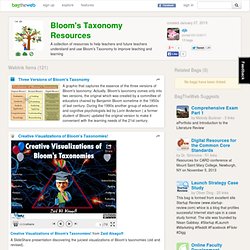
By design, it focuses attention away from content and instruction, and instead emphasizes the “cognitive events” in the mind of a child. And this is no small change. For decades, education reform has been focused on curriculum, assessment, instruction, and more recently standards, and data, with these efforts only bleeding over into how students think briefly, and by chance. This means that the focus of finite teacher and school resources are not on promoting thinking and understanding, but rather what kinds of things students are going to be thinking about and how they’ll prove they understand them.
This stands in contrast to the characteristics of the early 21st century, which include persistent connectivity, dynamic media forms, information-rich (digital and non-digital) environments, and an emphasis on visibility for pretty much everything. The Best Resources For Helping Teachers Use Bloom’s Taxonomy In The Classroom. Bloom’s & SOLO ‘are not Just Colorful Posters we Hang on the Wall’ is my two-part series at Education Week Teacher.

Bloom’s Taxonomy is talked about a lot in educational circles. However, if you believe a recent survey of visits to 23,000 U.S. classrooms, the higher-order thinking skills it’s ideally designed to promote doesn’t get much use. And I can understand why. It’s easy to get caught-up in the day-to-day work involved in teaching a class or multiple classes, and it’s easy to fall into the trap of doing the “usual stuff” and not “think out of the box.” I thought it might be useful to share in a “The Best…” list the resources that help me try to use Bloom’s Taxonomy in my classroom.
Bloom's Taxonomy of Learning Domains. Bloom's Taxonomy was created in 1956 under the leadership of educational psychologist Dr Benjamin Bloom in order to promote higher forms of thinking in education, such as analyzing and evaluating concepts, processes, procedures, and principles, rather than just remembering facts (rote learning).
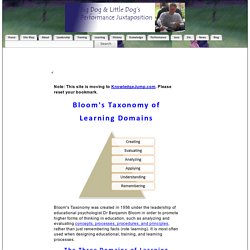
It is most often used when designing educational, training, and learning processes. The Three Domains of Learning The committee identified three domains of educational activities or learning (Bloom, et al. 1956): Cognitive: mental skills (knowledge) Affective: growth in feelings or emotional areas (attitude or self) Psychomotor: manual or physical skills (skills) Since the work was produced by higher education, the words tend to be a little bigger than we normally use. While the committee produced an elaborate compilation for the cognitive and affective domains, they omitted the psychomotor domain. Cognitive Domain Knowledge Comprehension Application Analysis Synthesis Evaluation Next Steps Review.
Definitions of Bloom's Taxonomy. Activities at Various Cognitive Levels of Learning (LoL) Bloom’s taxonomy of learning objectives is used to define how well a skill or competency is learned or mastered.

A fuller description of Bloom’s taxonomy is given in the following pages but a brief summary of the activities associated with each level is given below. Bloom's Taxonomy. Bloom's wheel, according to the Bloom's verbs and matching assessment types.
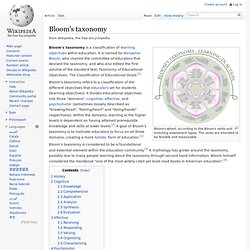
The verbs are intended to be feasible and measurable. A New Fantastic Bloom's Taxonomy Wheel for iPad Apps. March 21, 2014 Today while I was browsing through my Twitter feeds I came across this fabulous Bloom's Taxonomy wheel of apps shared by Anthony.

If you still recall, some previous versions of this wheel have already been featured here in Bloom's Taxonomy for Teachers section . As you can see, the wheel outlines a wide variety of verbs and activities related to each thinking level of Blooms taxonomy coupled with iPad apps that go with it. These apps are supposed to help teachers and students better cultivate these different thinking levels in their use of iPad apps.
And because the the visual is not hyperlinked, I went ahead and provided the links for each of these apps in the lists below. Enjoy Create Evaluate Annalyse Apply Remember/understand This wheel is originally discovered on the website of Paul Hopkin's education consultancy site mmiweb.org.uk adopted by Allan Carrington. How They Get It: A New, Simple Taxonomy For Understanding. How They Get It: A New, Simple Taxonomy For Understanding by Terry Heick How can you tell if a student really understands something?
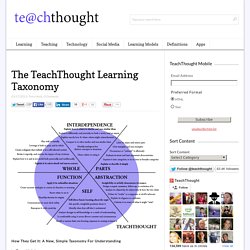
They learn early on to fake understanding exceptionally well, and even the best assessment leaves something on the table. (In truth, a big portion of the time students simply don’t know what they don’t know.) A New Wonderful Bloom's Taxonomy Visual for Teachers. Educational Technology and Mobile Learning: 20 Great Rubrics for Integrating Bloom's Digital Taxonomy in Your Teaching. June 15, 2014 I have always been inspired by the great work of Andrew Church.
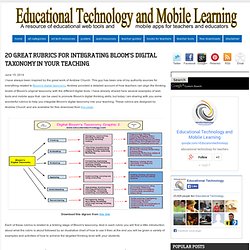
Taxonomy of Reflection. Web-based Version of Blooms Taxonomy (30+ digital tools ) How They Get It: A New, Simple Taxonomy For Understanding.